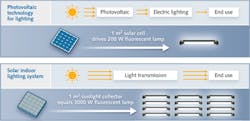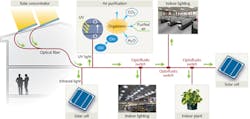WUZHOU SONG and DEMETRI PSALTIS
Reconfigurable solar lighting systems for indoor illumination could provide a new way to conserve energy that would otherwise be used for conventional lighting. To further this goal, we have demonstrated a compact, electrically tunable optofluidic light switch that could help pave the way to convenient solar lighting schemes.
Benefit of solar lighting
Sunlight was once the primary source of interior light for buildings in the daytime. However, as the cost, convenience, and performance of electric lamps were improved, the sun was, in many cases, displaced as our primary method for indoor lighting. In particular, public and commercial buildings rely on electric lights to a large degree, making them minimally dependent on natural daylight. Today, one of the largest uses of electricity in commercial buildings is in indoor lighting.1
To evaluate how sunlight can be efficiently used for illumination, we can consider two alternative solar energy systems for indoor illumination (see Fig. 1). In the first system, photovoltaic technology is used for indoor lighting. Solar cells capture sunlight and convert it to electricity with an efficiency of up to 20%. Then the electricity is converted back to light with an efficiency of 20%. As a result, at most only 4% of the solar energy is delivered as useful illumination energy.
In the second scheme for solar indoor lighting, the sunlight is captured on the building roof, concentrated, and routed with optical fibers to indoor overhead lamp fixtures with an estimated 20% transmission loss. Considering the fact that only visible light that occupies about 50% of the spectrum contributes to indoor lighting, the overall efficiency for illumination is about 40%, which is significantly higher than the photovoltaic method.
As another important benefit, natural sunlight contains the full visible spectrum and lets us see the world in its natural colors. To use sunlight for indoor illumination not only is a way of conserving energy, but also creates a comfortable and healthy indoor environment, keeping our minds alert and our bodies in balance.
Reconfigurable solar lighting
In a broad sense, solar lighting in the form of windows and skylights has been used for centuries. However, this lighting method lacks many valuable features that are available from electric lighting, including: (1) minimal space occupation; (2) independence from building structure; (3) illumination well into the interior of the building; (4) constant illumination level; and (5) illumination control (on/off, intensity).
To address the limitations that exist, we proposed a reconfigurable optofluidic solar lighting system for indoor illumination and energy conservation.2 This system can make full use of sunlight, while maintaining the advantages of electric lighting in terms of convenience, low space occupation, luminous stability, and illumination control.
The main idea is to couple sunlight into the fiber by using a solar concentrator installed on the roof of the building (see Fig. 2). The sunlight is then directed into each room for interior illumination, where the light flow is dynamically controlled by tunable optofluidic switches. This system can take advantage of the full sunlight spectrum. Because only the visible portion of the sunlight contributes to indoor illumination, both the infrared (IR) and ultraviolet (UV) portions of the concentrated light can be extracted for other applications if desired. For example, IR light can be directed to a thermoelectric generator; the UV portion of the sunlight can be extracted for photocatalytic air purification; and excess visible light can be further used for electricity generation by using solar cells when the sunlight is overabundant.
Optofluidic light switch
The optofluidic switch plays a key role in the reconfigurable solar lighting system. The switch has two main functions. First, the illumination level can be manually controlled by the end users in each lighting terminal. Second, since the sunlight intensity fluctuates due to weather conditions, optofluidic switches can respond in real time, hence keeping a constant illumination level at each lighting terminal. Low cost, compact size, high reliability, and low power consumption are the primary desirable features for such an optofluidic switch.
We recently demonstrated for the first time a compact tunable optofluidic switch based on the electrophoresis effect and scattering on the surface of an optical waveguide. The working principle of the optofluidic switch can be seen in Fig. 3. The main body of the device is a glass substrate coated with a transparent electrode, which is covered by a thin layer of dielectric transparent oil. Comb-shaped electrodes are arranged as an array of strips perpendicular to the light-propagation direction. Here, the glass substrate functions as a multimode slab optical waveguide. Without applying voltage to the electrodes, the surface of the oil film is smooth, and the light propagates along the waveguide without leakage.
However, upon applying voltage across the electrodes, these interdigitated strip electrodes create a highly nonuniform periodic electric-field profile. The oil film experiences dielectrophoretic force and surface deformation, which further induce scattering of the guiding light propagating along the waveguide.3 The amount of the scattered light depends on the amplitude of wrinkling at the oil surface, which can be controlled by the voltage applied across the electrodes.
A comparison of the experimentally observed "off" and "on" states in the optofluidic switch is seen in Fig. 3b. When the applied voltage was off, there was a slight light leakage at the edge of the glass waveguide due to the roughness of the side wall. When 800 V was applied, strong light leakage was observed from both the top and bottom sides of the waveguide, and the leaked light power was controlled by the applied voltage.
We also found that the orientation of the device has negligible effect on the switching performance, which indicates that the thin oil film was stable enough even when the substrate was tilted or turned upside down. A modulation frequency of 2 Hz was achieved and should be adequate for active light control in most solar lighting applications.
Low power consumption is another important feature of the optofluidic switch. When the switch is turned on by applying 800 V, the electrical power consumption is only 41 μW. Ideally, the device should achieve even lower power consumption if the dielectric oil is further purified.
This optofluidic switch can be easily extended to larger scales by enlarging a single device or assembling many of them. In addition to the use of reconfigurable solar lighting for indoor illumination, the optofluidic switch could be integrated with an optofluidic reactor in which light illumination is directed onto microalgae or a photocatalyst could be arbitrarily controlled by the electrical signal.4 Moreover, many such optofluidic switch units could be integrated onto a single panel for an indoor display or light decoration. We expect such optofluidic switches could pave the way for various solar lighting applications that would promise a novel way for energy conversation as a complimentary method to photovoltaic technology.
REFERENCES
1. L. M. Fraas et al., Appl. Opt., 22, 578 (1983).
2. W. Song and D. Psaltis, Lab Chip, 13, 2708 (2013).
3. C. V. Brown et al., Nat. Photon., 3, 403 (2009).
4. D. Erickson et al., Nat. Photon., 5, 583 (2011).
Wuzhou Song is currently a postdoctoral fellow at the School of Engineering & Applied Sciences (SEAS), Harvard University, Cambridge, MA; email: wsong@seas.harvard.edu. Demetri Psaltis is a professor and dean of the engineering school at École Polytechnique Fédérale de Lausanne (EPFL) in Switzerland.


